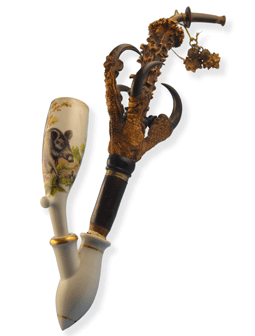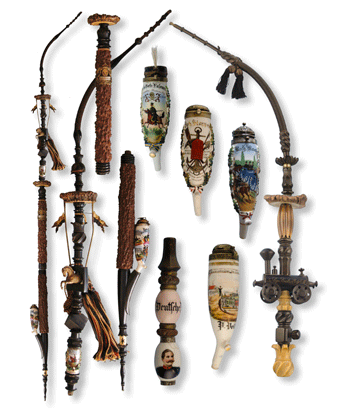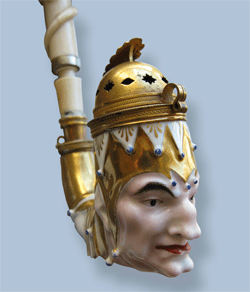|
The Porcelain Pipe: A Smoker’s Nightmare, A Collector’s Dream
By Ben Rapaport
Posted January 2017

The study of tobacco pipes in their various formats and materials is essentially an investigation into a cultural, social and behavioral branch of the social sciences. Through time, the tobacco pipe became an object of much inventive ingenuity, and it varied as greatly in material as in form: wood, horn, bone, ivory, precious stone, precious metals, amber, glass, porcelain and clay being the materials employed in various forms.
|

|

|
|
Porcelain bowl, gilt-trimmed portrait of a refined couple, ivory reservoir, stem and mouthpiece, 19th c. (Sarunas Peckus Collection, Darius Peckus photographer)
|
The bowl depicts a wild boar, and the stem is a hawk’s talon, early 20th c. (Sarunas Peckus Collection, Darius Peckus photographer).
|
Of all these materials used in the fabrication of tobacco pipes in the last 400 or so years—including the humble corncob and the briar introduced in the mid-19th century—the porcelain is the singular pipe that failed to get universal acceptance in the modern world. What’s been written about it—a European, not an American, pipe—is, surprisingly, minimal; the available information is sparse and limited to secondary sources for the earliest years of production, and almost nothing of substance has been published about the later years. Only one serious treatise in German has been devoted to recounting almost 300 years of that country’s porcelain pipe industry, and no French book, to date, has documented the evolution of that country’s stellar porcelain pipe production.
|

|
Meissen figural of a seated bear, turned wood stem, ivory mouthpiece, c. 1750. (Sarunas Peckus Collection, Darius Peckus photographer)
|
Hundreds of thousands of porcelain pipes were manufactured from the mid-1700s through the early 1920s in Germany, a lesser output in France and Austria, and a minor production in Denmark and Holland. The most respected German manufactories at the time, Königliche Porzellan-Manufaktur (KPM, The Royal Porcelain Factory, Berlin), Limbach, Meissen, Nymphenburg, and the French centers Chantilly, Mennecy, Saint-Omer and Sèvres and others produced porcelain tobacco boxes and snuffboxes. They soon realized that the increasing demand for fine-quality, hard-paste, hand-painted pipe bowls was a merchandising opportunity not to be missed.
The porcelain tobacco pipe generally associated with Germany consisted of a porcelain bowl connected to a stem and to a hollow slightly V- or U-shaped chamber of porcelain, horn or wood, the bowl fitting into one opening of the chamber and the stem into the other opening. The purpose of the chamber, known as abguss, or reservoir, was to act as a repository for the juices and tar so as to improve the fragrance and taste of the tobacco. The stem ranged from one foot to four feet in length. Stems came in assorted mediums and degree of ornamentation, ranging from plain cherry wood to very ornate, relief-carved or turned antler, bone, ivory, wood or metal. It terminated, most often, in a mouthpiece of buffalo horn. If the bowl required a metal lid, it could have been plain simple openwork or elaborately pierced and chased…a gem of the silversmith’s craft.
|

|
Assorted components of the German Reservistenpfeife (Reservist or Regimental) pipes, late 19th c. (Sarunas Peckus Collection, Darius Peckus photographer)
|
The height of German mass production was during the Franco-Prussian War (1870-71) when factories were commissioned to make military-themed porcelains for those in uniform. This particular pipe, adorned with many martial symbols, was known as the Reservistenpfeife, the Reservist or Regimental pipe, a token of remembrance, a memento of military service, an element of nostalgia. In the 1950s-1970s, there was a brief manufacturing revival in Germany to replicate both the Regimental and other assorted porcelain bowls exhibiting kitschy, touristy, commonplace themes using applied decals, but interest in collecting these waned rapidly.
|

|
Various bowls illustrating the coats of arms from German university fraternities, 19th c. (Sarunas Peckus Collection, Darius Peckus photographer)
|
As to their popularity, I quote “The Pipe in Germany,” Cope’s Tobacco Plant (March 1874): “The porcelain pipe is an emblem of old ‘fatherland’ to every Teuton, when he thinks of the ‘long ago’ and the ‘old friends far away.’” According to F. W. Fairholt, Tobacco: Its History and Associations: Including an Account of the Plant and Its Manufacture; with Its Modes of Use in All Ages and Countries (1859): “These bowls are sometimes very beautifully painted, and a dealer’s stock exhibits a vast variety of subjects, sacred and profane, religious and historic, varying in price according to quality of workmanship.” Also in the Encyclopedia Americana (1840), there is this: “The fine porcelain bowls are wrought with much elegance, and are articles of very considerable luxury.”
Ideas for images on pipe bowls came from a very broad expanse of inspiration: the arts, music, literature and the occurrences of daily life throughout those 100 or so years: the celebration of wars and the peace treaties; the birth, coronation, and deaths of kings and queens; the rise and fall of political figures, luminaries and celebrities; commemorative events, both joyous and sad; landmarks; the trades and professions; the chase and the hunt; religion; and fairy tales and legends, domestic and convivial. Other subject matter also included the humorous, the ornamental, and the occasional metamorphic, suggestive, erotic, pornographic, and scatological. The choices of motif or theme, configuration, relief ornamentation and price were literally endless. Sadly, with the discovery of transfer printing in colors during the middle-to-late 19th century, this process began to rapidly supersede the more laborious process of hand painting.
Pipe smokers in Great Britain and in America, accustomed to smoking the clay, the meerschaum, and the briar, rejected the porcelain because the substance is non-porous—the reason for the reservoir—and therefore, a highly unpleasant pipe to smoke. Age and use do not improve it. “A smoker ought not to be a bottle or bowl washer: a porcelain pipe is utterly useless to him,” stated the anonymous author of Smoking & Smokers (1845). Or most succinctly put a century later by Sidney Ram (How to Get More Fun Out of Smoking, 1941): “Porcelain pipes are tongue-burners.” And Joaquin Verdaguer (The Art of Pipe Smoking, 1958) condescendingly remarked:
If someone should present you with one of the monstrosities made in Meissen or Sevres [sic], shove it immediately in your china cabinet. Don’t put the darn thing in your mouth! It belches out redhot smoke, scorches the tongue, soils everything in sight and—what is worse—remains completely aloof. Reticent from the first to the last day, it burns up tobacco without emitting that mysterious, sweet and enchanting aroma that every decent pipe wants to bestow on its master.
Not unexpectedly, the Dictionnaire de la Conversation et de la Lecture (1838) boldly declared: “Sans contredit, les meilleures pipes sont les pipes de porcelaine”! (Indisputably, the best pipes are porcelain pipes!) A few years later, there is this from Germany in further defense of the porcelain appearing in Illustriertes Lexicon der gesammten Wirthschaftstunde Für alle Stände (1855): “Die von Porzellan sind die reinlichsten und gesundsten.” (Those [pipes] of porcelain are the cleanest and healthiest.)
As previously mentioned, although the American pipe smoker rebuffed the porcelain, the mail order catalogs of Sears, Roebuck & Co. and Montgomery Ward in the late 1800s and early 1900s included illustrations of cheaply made, mass-produced “Long German Porcelain Pipes” at the nominal price of $0.85.
|

|
A very rare format for a porcelain pipe: elephant head bowl with turned buffalo-horn stem, late 19th c. (Sarunas Peckus Collection, Darius Peckus photographer)
|
A careful survey of the myriad shapes, sizes, styles and symmetries of this pipe class reveals a host of spectacular exemplars. Many of these old porcelains are available on eBay, particularly eBay Germany. Offers most often are for post-1900 transfer-painted bowls of deer, dogs, hunt scenes, flower sprays and military motifs, but “da good stuff’ commands exceptional prices at European auctions. Two examples suffice to prove this point. Bonhams, New Bond Street, London, conducted an auction of fine European ceramics on June 15, 2016. In it were two porcelain pipe bowls sans their respective stems and mouthpieces. Lot 164, “A Nymphenburg silver-gilt-mounted pipe bow, circa 1765,” with an estimate of £800–1,200 ($1,200–$1,700), sold for $1,636. Lot 169, “A Nymphenburg pipe bowl pipe bowl in the form of Turk’s head, circa 1763,” with an estimate of £2,500–3,500 ($3,600–$5,100), sold for $6,220. The buyers? No doubt, Continental antique pipe collectors.
Want to start a collection with something new instead of antique? On the other end of the price-point spectrum are contemporary-style porcelain pipes from Denmark’s Royal Copenhagen selling at a very nominal price. Or search online for porcelain pipes produced in the Czech Republic (now Czechia), a thriving center of pipe manufacture.
|

|
Polychromatic head of a court jester in French hard paste, Le Bouffon du Roi (the king’s clown), Sèvres, c. 1830-1860. (WCC Collection, WCC photographer)
|
It’s an irrefutable fact: collectively, porcelain pipes represent a veritable feast of fabulous, fantastic designs and motifs, renaissance and romance artistry and, as evidenced in these illustrations, a richly colorful accouterment of smoke devised and developed in the age of aristocratic elegance—the 18th century—and popularized in the age of industrialization—the 19th century—for use in a once-manly social pastime. However, today’s pipe smoker might conclude that the porcelain pipe is much more practical for show than for use; they are objets d’art in a collector’s display case. “Sufficient to add that, a porcelain pipe should be in the battery of every true pipe-smoker,” averred Georges Herment (The Pipe, 1954). Sixty odd years later, I am compelled to add: “...and in the battery of every true pipe collector.”
-----------------------
If Ben Rapaport has piqued your interest, read a well-crafted, but brief, online account, “Moments. Porcelain: The Illustrated Pipe” (alpascia.com) or purchase the only English-language volume illuminating the lengthy history of this continental pipe genre written by Peckus and Rapaport, The European Porcelain Tobacco Pipe. Illustrated History for Collectors (2014). This is Ben’s eighth book on the interrelated topics of tobacco and pipes. If you own an antique porcelain pipe and desire further information about it, or tips on how to collect them, contact him at ben70gray@gmail.com.
|